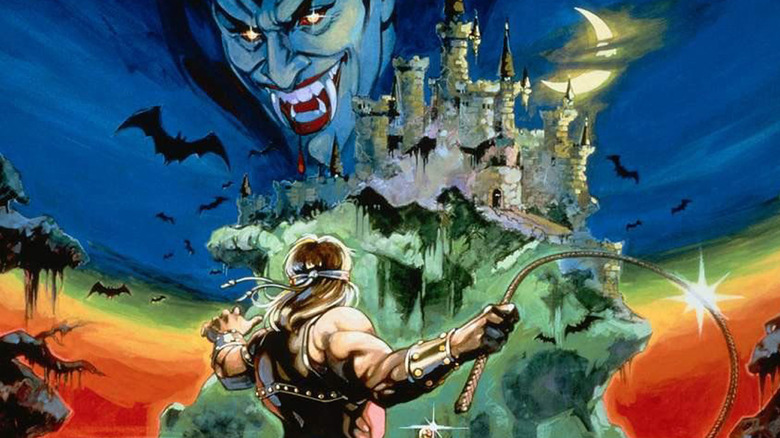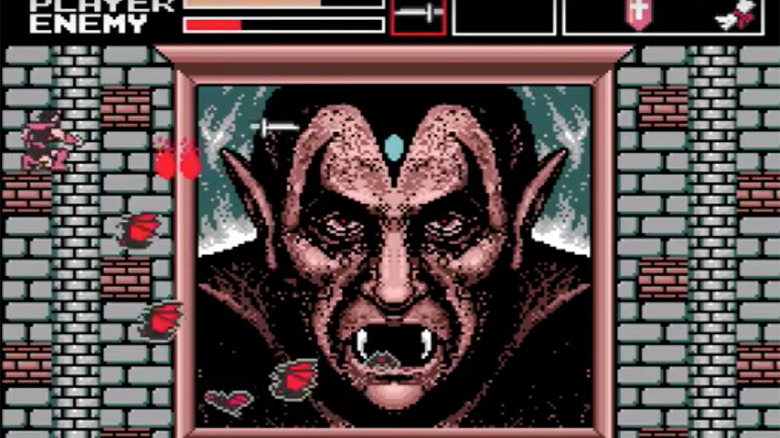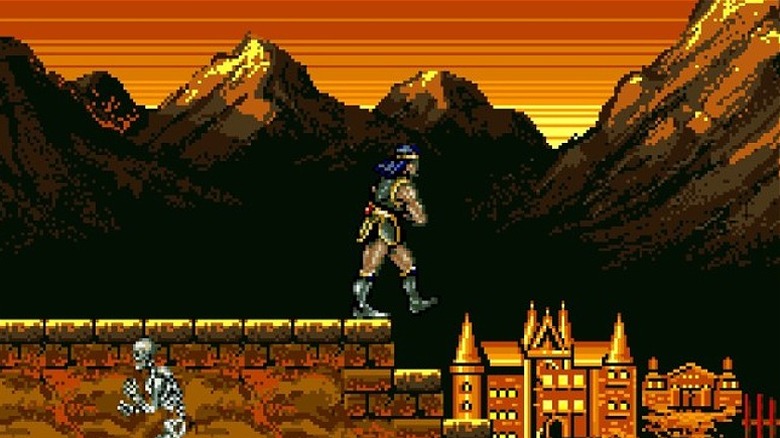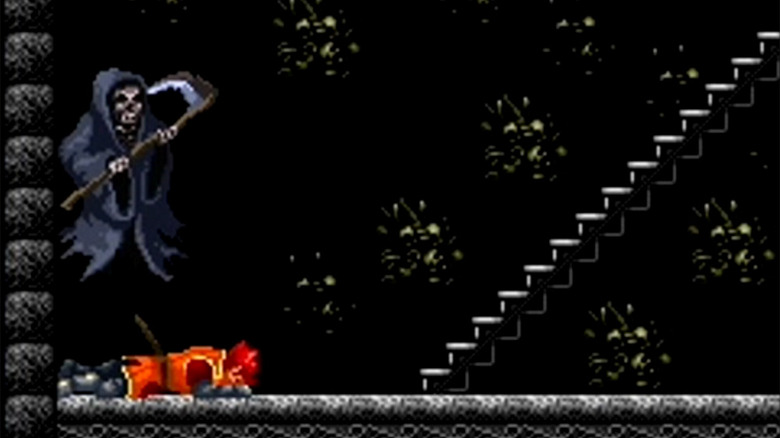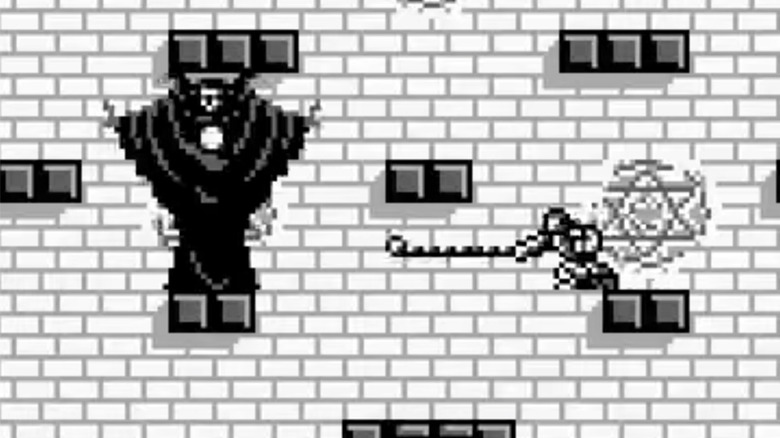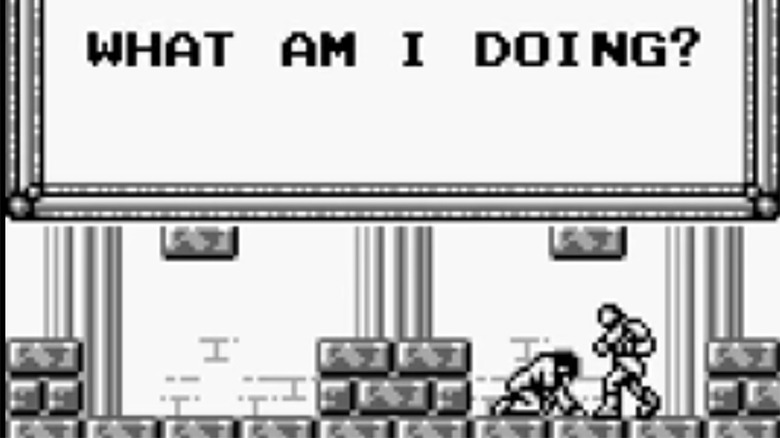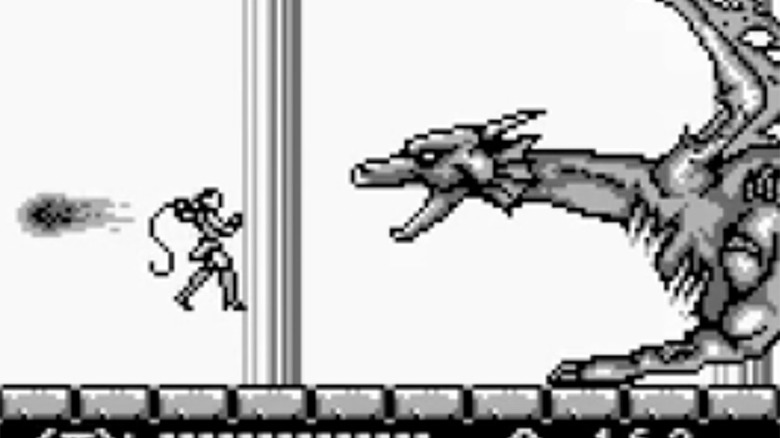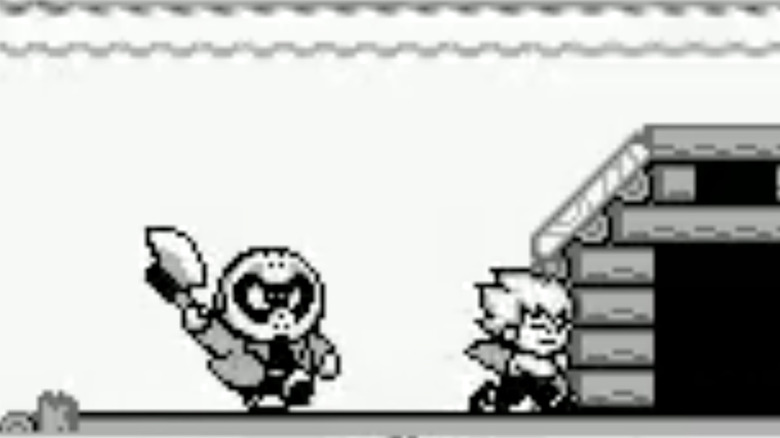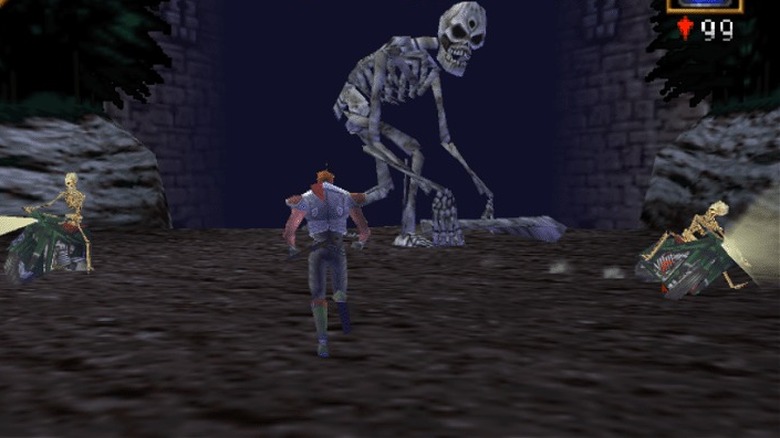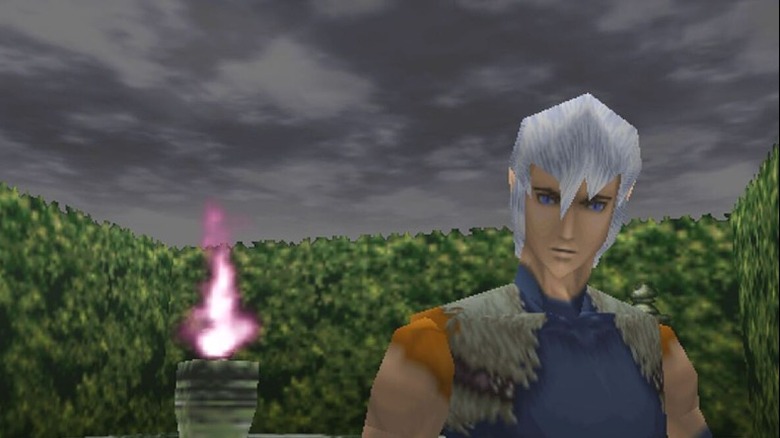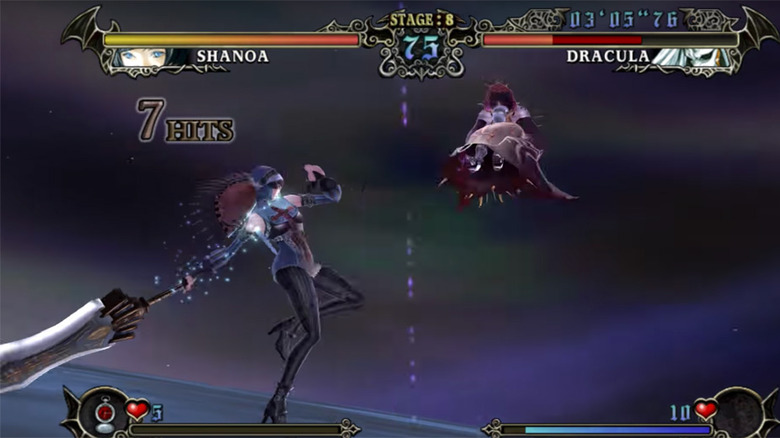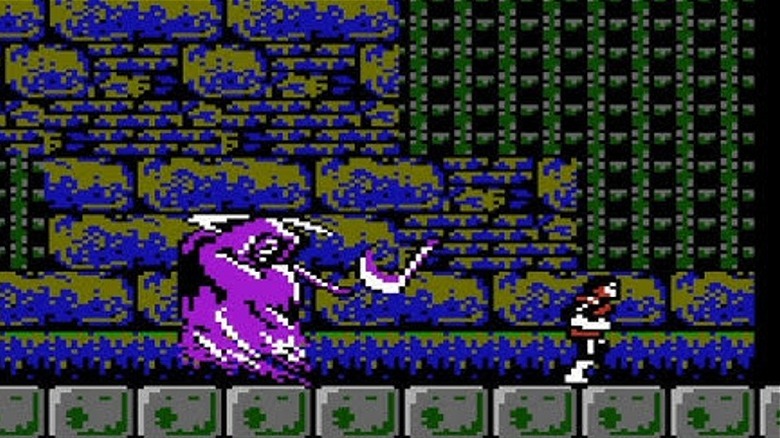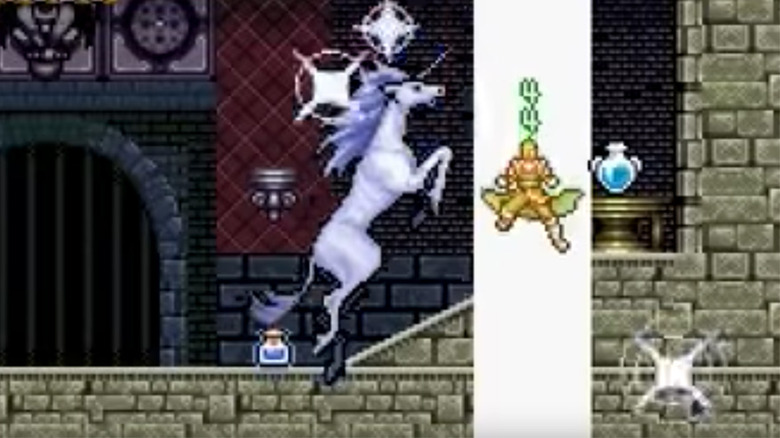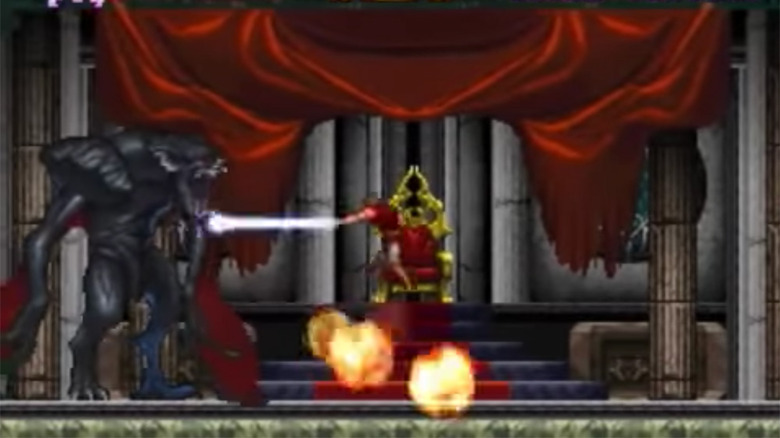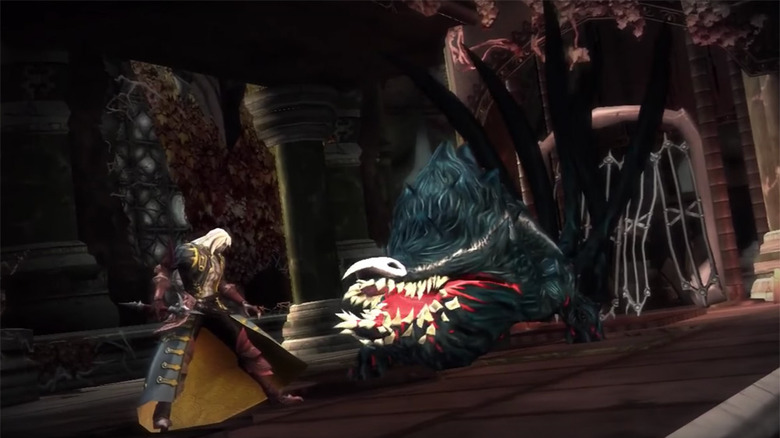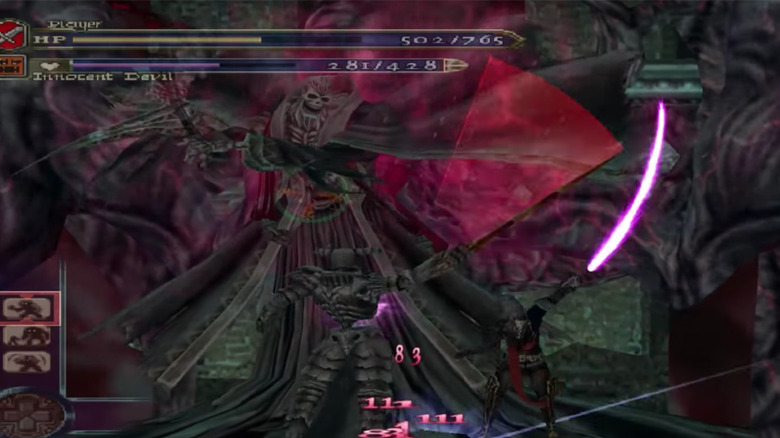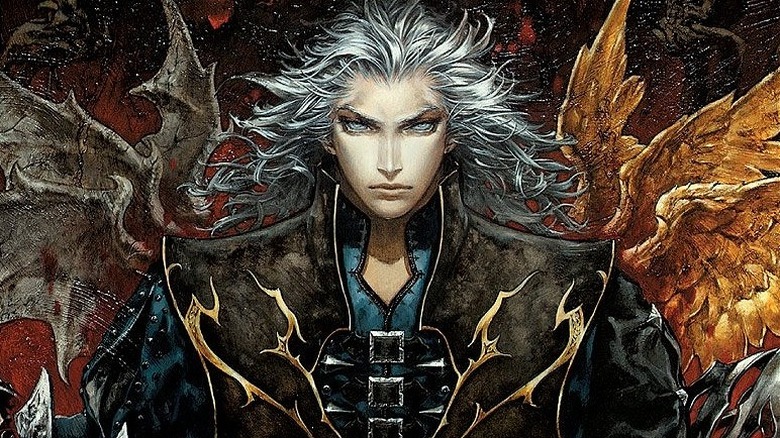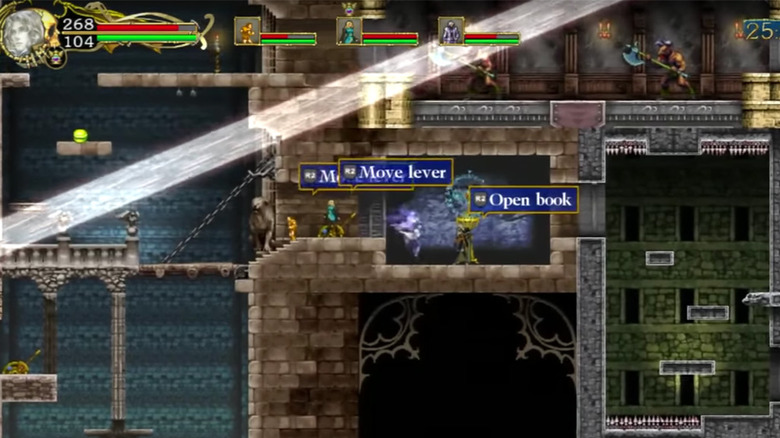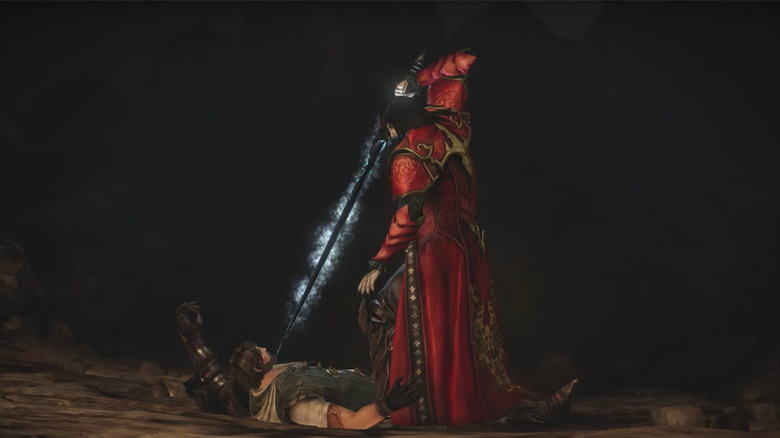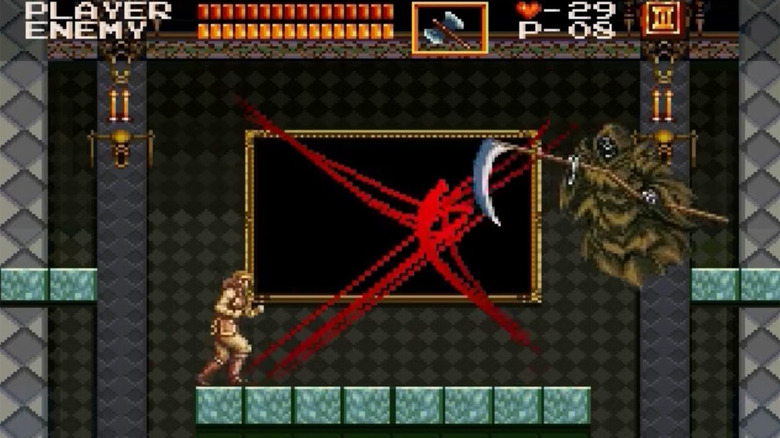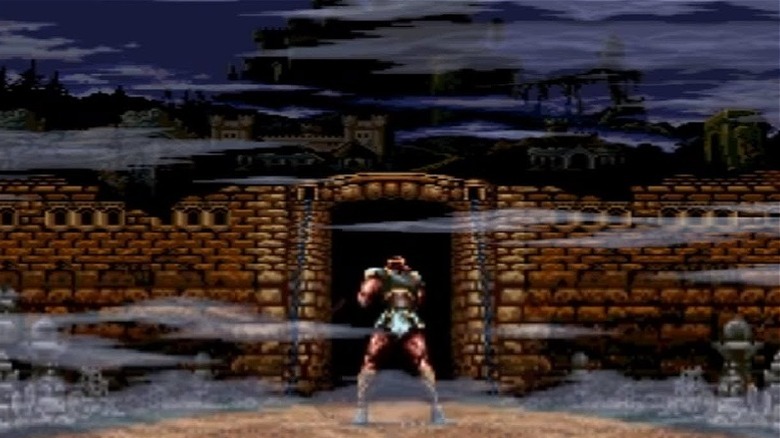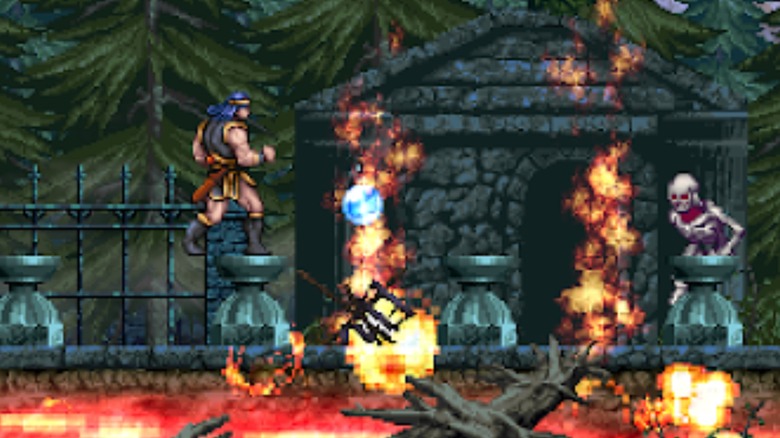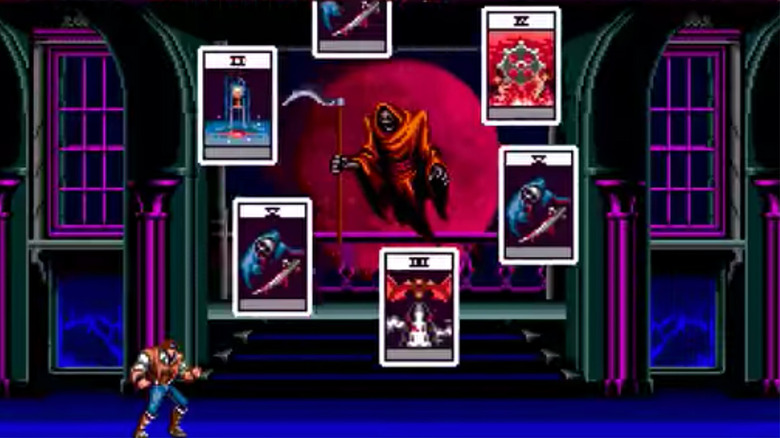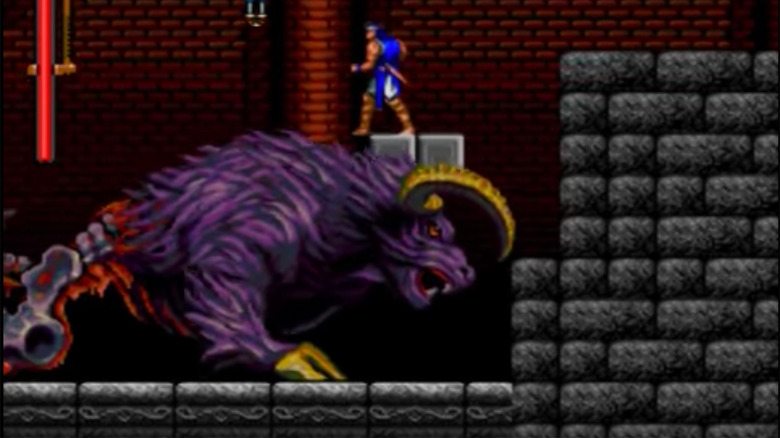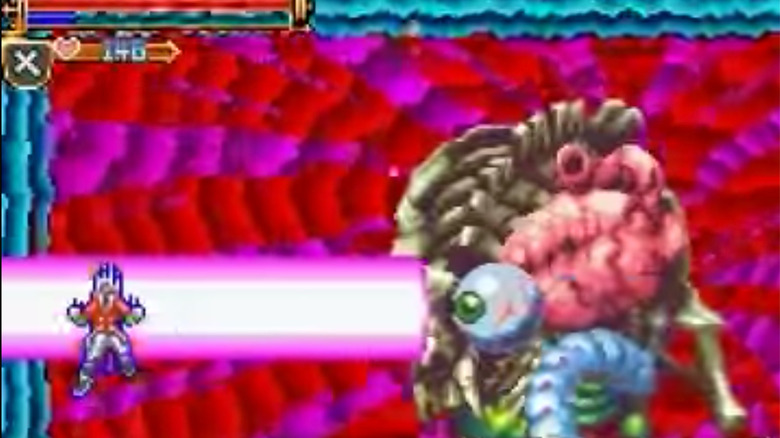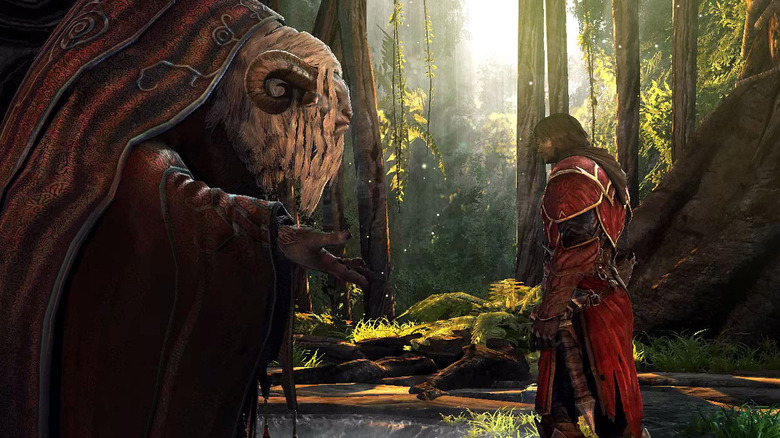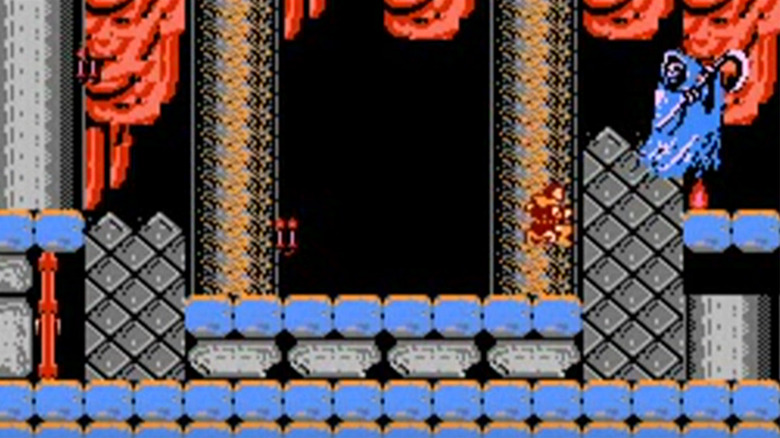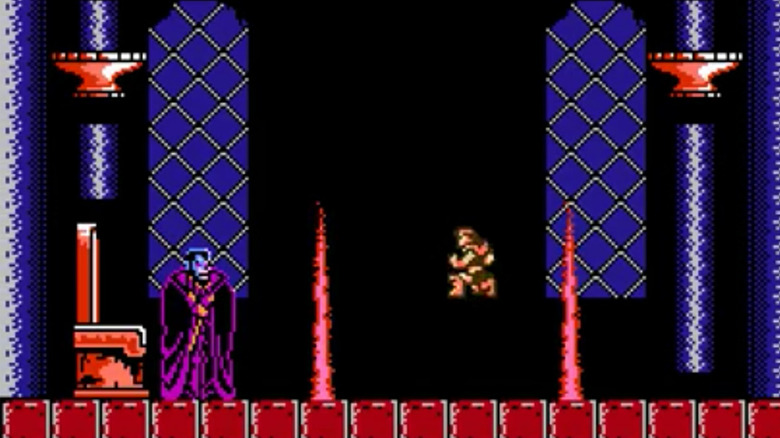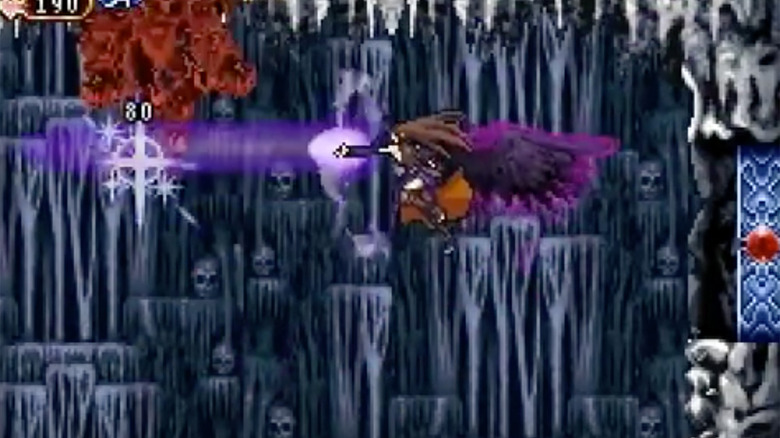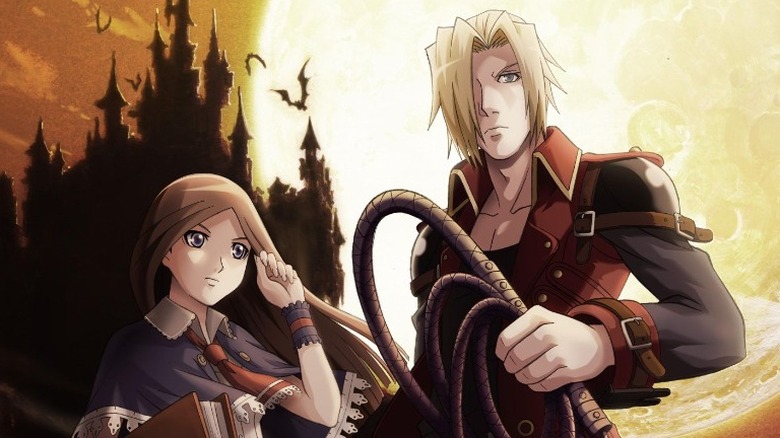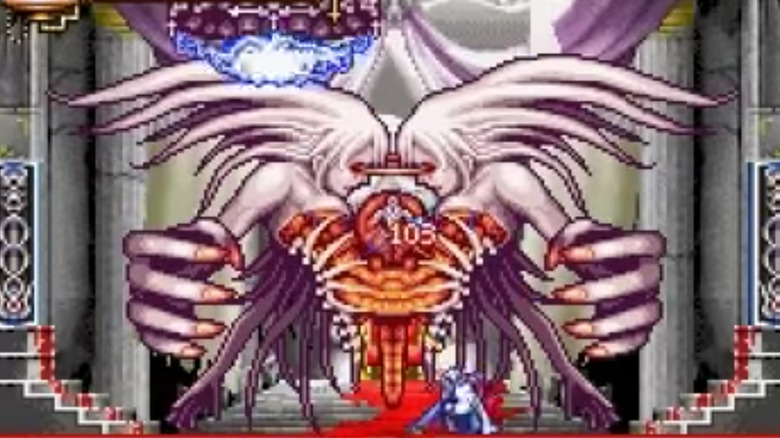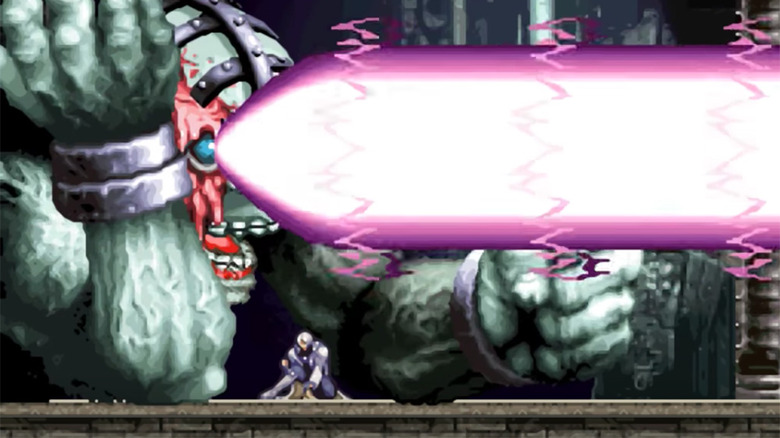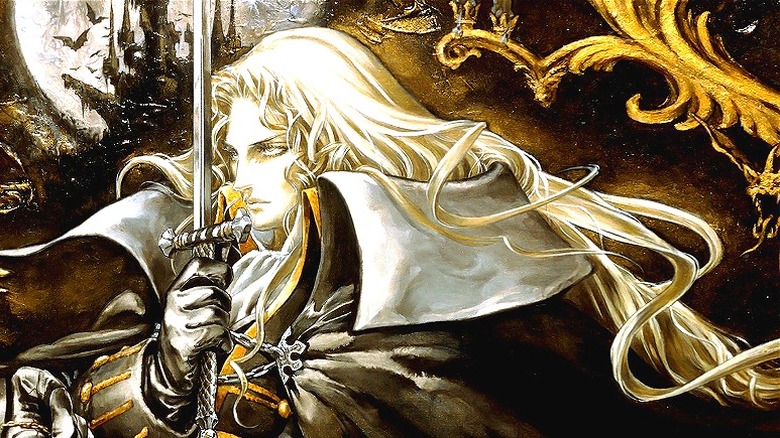Every Castlevania Game Ranked Worst To Best
It started with the simple idea of mashing up Conan the Barbarian with Indiana Jones and then sending him off to fight everyone's favorite movie monsters, but over the past 30 years, "Castlevania" has grown to become one of gaming's most storied horror franchises. The sprawling timeline, focused on a family of vampire hunters and their immortal foe, has been told through epic stories of magical whips, castles that are themselves creatures of chaos, and even the 21st century cool teen reincarnation of Dracula, with some truly weird side projects thrown in for good measure.
But with over 30 different games in the core franchise, "Castlevania" has as many missteps as it has masterpieces. That's why we've whipped ourselves into a fervor, opened our hearts, and traced the bloodline of the franchise all the way from its lowest points to the dizzying heights of an inverted castle. Here's every "Castlevania" game ranked from worst to best!
33. Vampire Killer (1986)
More than anything else, what made the original NES "Castlevania" great was its well-considered design. Even though it was divided into distinct stages, it felt cohesive, and even enemy placement was geared towards providing a rewarding experience. Without that thoughtfulness, it just would not be as good a game. And we know that because we have "Vampire Killer."
While the series would later find huge success by focusing on exploration, the Belmont clan's second outing was built of stages that looped endlessly until you found a key that would allow you to progress, sacrificing the original game's linear clarity and memorable progression in the process. It's not the most crushingly bad example of a "Castlevania" game, but it's definitely the most boring, and that makes it even worse.
32. Haunted Castle (1988)
The arcade port/remake of the original "Castlevania" is not without its merits. While it doesn't look as good as some of its contemporaries — and the hilariously bad, inexplicably tiny rendering of Simon Belmont who's half the size of a chair doesn't help — the graphical capabilities of the arcade allowed "Haunted Castle" to do some pretty interesting stuff. A portrait sheds a bloody tear as you pass, a flaming brazier falls to the ground and sets a fire to create a platforming challenge, and other interactive background elements add a huge thrill to the battle against Dracula's castle.
Unfortunately, that's about where the good stuff stops. "Haunted Castle" is crushingly, unfairly difficult, and the fact that you only have one life to make it through the entire game makes it less of a game and more of a blatant attempt to part you from your quarters. Throw in some terrible controls, and you're left with something that's virtually unplayable.
31. Castlevania: Order of Shadows (2007)
If you've never heard of "Order of Shadows," there's a good reason for that: It's a little-known later-era entry in the series that came out for mobile phones, and is about as good as you'd expect from that description.
While it touted itself as a mobile successor to "Symphony of the Night" — something that we already had plenty of better attempts at, if you consider Nintendo's handhelds to be "mobile" — its attempt at capturing that magic was mostly built around an unnecessary surplus of weapons. The rest of the game was built from half-hearted action-RPG mechanics, awkward controls, and a truly miniscule roster of enemies that, according to Wired's crushing 3/10 review, was limited to only 13 foes. In a world where games like "Aria of Sorrow" exist, "Order of Shadows" is absolutely pointless.
30. Castlevania: The Adventure (1989)
In the 21st century, handheld systems like the Nintendo DS would be the home for the true bloodline of "Castlevania," offering up memorable, classical titles while next-gen platforms dithered around with various attempts at 3D action games. In 1989, though, "Castlevania: The Adventure" proved that translating what made the series great into a more portable form wasn't as easy as it would eventually look.
While there's some decent action here, it's tanked from the first moments by the limitations of the original Game Boy. They're a lot better in a world with emulation, but the graphics on the GB screen were laggy and muddy, and Christopher Belmont moves across his time-limited stages with the speed of a narcoleptic glacier. For the time, it was just okay, but there's a good reason it's not that fondly remembered.
29. Castlevania II: Belmont's Revenge (1991)
On the one hand, "Belmont's Revenge" was certainly an improvement over its predecessor (which was the Game Boy game "Castlevania: The Adventure," not the original "Castlevania" for the NES). On the other hand, how could it not be?
The game's most notable feature came with the addition of a "Mega Man"-style stage select screen that allowed players to journey through different stages before Wily's — er, Dracula's Castle erupted from the ground to set the stage for the final conflict. It added a bit of the open-world style that would come to fruition in later games. Sadly, while it's far more playable than its predecessor, its set 15 years after "The Adventure" and good ol' Chris Belmont doesn't seem to have spent any of the intervening time getting any better at running. If you're a Game Boy fan, it's worth checking out, but compared to a masterpiece like "Castlevania 3," there's not much to it.
28. Castlevania Legends (1997)
"Castlevania Legends" is definitely the least-loved entry in the Game Boy's Belmont trilogy, to the point where Koji Igarashi removed it from the official timeline and. In an interview with Nintendo Power, he even called it "something of an embarrassment."
That's a shame, because all things considered, it's not a bad game, and might actually be one of the most underrated gems of the GB era. It shares the graphical limitations of the previous games, and it suffers by the comparison of being a contemporary with the masterpiece that is "Symphony of the Night," but it delivers a far more playable experience that captures the feel of a classic "Castlevania" than any other title. Plus, Sonia Belmont marked the first time that the games had featured a solo female protagonist — something that would be a rarity for the franchise until "Order of Ecclesia."
27. Kid Dracula (1993)
"Kid Dracula" was another one of those part-sequel/part-remakes that were so popular when major gaming franchises shifted from the NES (or in this case, the Famicom) over to the Game Boy. As a result, it's mostly just a monochromatic take on Lil' Drac's first appearance, albeit the only one that American audiences got to play. It's mostly notable for its boss fights, and while they never quite get as bizarre as they did on the Japan-only Famicom "Kid Dracula," battling it out with a cartoony Jason Voorhees is pretty notable.
It might just be a part of the franchise in only the most technical sense, but it's easily the best, most fun game about Dracula that Konami made for the original Game Boy. Also, since the American translation says Kid Dracula is Regular Dracula's son, that means that this is actually Alucard's origin story. That's pretty weird, right?
26. Castlevania (1999)
To say that the attempts to bring "Castlevania" to the world of 3D gaming underwhelmed is putting things so mildly that you might as well write it on a piece of white bread. The first attempt came on the Nintendo 64, and resulted in what is unquestionably the worst main-series "Castlevania" game ever made.
To be fair, it's not entirely without redeeming qualities. There's some good music and a few of the boss fights are interesting, but that's balanced out by awful controls, an infuriating (and nauseating) camera, and bland levels rendered in blocky polygons that look like a toddler's scribbles compared to the highly detailed sprites gamers had seen just two years before. Konami tried for a solid decade to make a 3D "Castlevania" happen, but with a first step like this, it's shocking there was ever a second one.
25. Castlevania: Legacy of Darkness (1999)
If you liked "Castlevania" for Nintendo 64 — and be honest, you didn't — then we've got some good news! About nine months after it originally came out, someone over at Konami decided that maybe they should go back and finish making it.
The result was "Legacy of Darkness," a kind-of-sequel to, kind-of-remake of what they'd already done. It put the focus on a few other characters, and to be entirely fair, it is a far better experience than the massive letdown that was "Castlevania 64," doing a much better job blending the action with a sort of "Resident Evil" style of exploration. That said, it's by no means a good game, and represents a branch of the series that's better left forgotten. At the end of the day, a better version of "Castlevania 64" is just a better version of bad.
24. Castlevania: Judgment (2008)
Of all the games to bear the "Castlevania" name, "Judgment" might be the weirdest. It's easy to see why Konami and Koji Igarashi thought it would be a good idea, though: It's a cross-time fighting game that pulls in characters from throughout the history of the franchise, gives them redesigns by the artist of "Death Note," and drops them into interactive environments to fight to the death — or undeath, as the case may be.
Unfortunately, the road to a terrible game is often paved with good intentions. The reliance on the Wii's motion controls make playing through "Judgment" an awkward chore, and to put it bluntly, "Death Note" artist Takeshi Obata's redesigns are bad at best and, in the case of characters like Carmilla and Dracula, occasionally downright embarrassing. It's interesting for its novelty, but almost impossible to recommend on its own.
23. Castlevania 2: Simon's Quest (1987)
The best thing you can say about "Simon's Quest" is that it has some good ideas. It just fails to put any of them together in a way that's fun. The open-ended world, the fumbling steps at action-RPG mechanics, the multiple endings, the mysteries to figure out, and even the day-night cycle that finds the sanctuaries overrun by monsters until the sun rises again: all of these are fantastic elements that would serve as a prototype for what a 21st-century "Castlevania" game would be.
Unfortunately, they're clunky to the point of being nearly unplayable, and a poor translation that introduced the world to the "Graveyard Duck" didn't help. Even worse, it's a "Castlevania" game that doesn't actually have Castlevania in it. Modern fans have produced remakes that try to fix its more egregious problems, but those just reveal that at its core, Simon's Quest is a fundamentally bad game, full of elements that were a decade ahead of their time.
22. Akumajo Special: Boku Dracula-kun (1990)
As a standard issue 8-bit platformer, this game is all right, but as a bizarre artifact of its time, it's a must-play. It's really just a "Castlevania" title in name only, with a vague connection to the series, including the hilarious fact that cute young Dracula looks exactly like Soma Cruz. By the time you get to a "boss fight" that's just the Statue (Goddess?) of Liberty asking you game show questions, the tenuous connection hardly even matters anymore.
It's a little surprising that it only took a few years for the "Castlevania" franchise to descend into full-on parody, but the Famicom take on "Kid Dracula" is surprisingly fun and monumentally weird.
21. Castlevania: Circle of the Moon (2001)
"Circle of the Moon" is so close to being a great game, but close only counts in horseshoes and holy water. Instead, its flaws make it one of the hardest to actually get through.
On the plus side, it has a (vampire) killer soundtrack, a great (if compact) castle layout, and a cool story that sees you fighting your way up from the depths of the castle rather than approaching it head on. Unfortunately, it's also saddled with an achingly slow protagonist and graphics that would've been great on a console, but accentuated everything bad about the original Game Boy Advance's murky screen. To make matters worse, the "DSS" attack system had interesting ideas, but making the cards into random drops led to endless grinding that just wasn't fun.
20. Castlevania: The Adventure ReBirth (2009)
In all honesty, you should never play "Castlevania: The Adventure." If, however, you absolutely need to — like maybe you lost a bet, or got sentenced to it for some minor crime — then this is the version you should play.
As part of the modern trend of giving older titles a more modern-styled remake, "The Adventure ReBirth" was a Wii-exclusive take on the original Game Boy "Castlevania," with updated graphics and controls, as well as all the shiny bells and whistles you'd expect in a post-"Symphony of the Night" world. It's a solid title that actually does fix a lot of what went wrong with the original "Adventure," but it also raises the question: If you're going to remake and re-release any "Castlevania" game in 2009, why make it this one?
19. Castlevania: Lords of Shadow — Mirror of Fate (2013)
"Mirror of Fate" is not a good game, but you almost have to respect its audacity. While it abandons the traditional sprites for polygonal graphics, it's an interesting attempt to bridge the side-scrolling Metroidvania style that had produced so many great titles with the self-serious grimness of "Lords of Shadow." It takes plenty of inspiration — maybe even too much — from "Castlevania 3," asking players to go through the castle with different characters whose abilities open up different pathways. Unfortunately, the castle itself is boring and counterintuitive, and despite the different characters, playing through the same bad environments three times is about as fun as it sounds.
Still, the way it twists the mythology is hilarious. It picks up on the "what if a Belmont was Dracula?" idea from "Lords of Shadow" and takes it to its logical conclusion: If Trevor Belmont is Gabriel's son and Gabriel is Dracula, then Trevor must also be Alucard, right? Which makes Alucard Simon Belmont's dad! It's a wild departure that only makes sense if you already know the mythology behind the games (which in turn defeats the point of a reboot), and it almost makes it worth playing to get to the jaw-dropping nonsense of the reveals. Almost.
18. Castlevania: Lament of Innocence (2003)
Of the three attempts to give a canonical origin story for the Belmont family that would explain why they spend all their time trying to beat Dracula to death with a whip, "Lament of Innocence," in retrospect, might be the most ill-advised.
It's certainly more polished than "Castlevania Legends," and far more playable than any of the other current-console titles of its time, with straightforward action gameplay that does a good job of translating what's great about the side-scrolling games into a 3D space. Unfortunately, it's also saddled with some voice acting that verges on hilariously bad, and the Vampire Killer whip's origin story — in which you have to kill your fiancée so that her soul can bond with your whip to make it more powerful — is a one of gaming's most egregious examples of literally turning a woman into an object.
17. Castlevania: Curse of Darkness (2005)
With so many sequels that step backwards, it's actually kind of surprising that "Curse of Darkness" actually did take everything that "Lament of Innocence" did well, and did it better. The action is more fluid, the boss fights are bigger and more exciting — whoever decided that the final battle against Dracula should basically be the Master Hand fight from "Smash Bros. Melee" but with Satan should've taken the day off — and the plot lacks the bizarre excesses that we got with the previous entry in the franchise.
It's clearly "Castlevania" trying to do what "Devil May Cry" had already done better, but that's not really a bad thing. If you're going to steal, steal from something that already felt like "Castlevania, right?
16. Castlevania: Harmony of Despair (2010)
As an online co-op action platformer for the Xbox 360 and PlayStation 3, "Castlevania HD" (get it?) pits a team of vampire hunters against remixed "greatest hits" versions of the castle, rushing against a time limit to fight their way through an army of monsters and take down a boss. While its novelty is quick to wear off — and while it lacks any sort of interesting solo mode that could give it some replay value — it does a great job with its simple premise, and makes the most of seeing, say, Alucard and an 8-bit Simon Belmont teaming up. If there's one thing it does well, it's trade on the knowledge that if you're playing it, then you probably already like Castlevania enough to get a kick out of seeing it all mashed up.
Much like "Judgment," "Harmony of Despair" is an unusual experiment. The difference is that this time, it still feels like "Castlevania."
15. Castlevania: Lords of Shadow 2 (2014)
In practice, "Lords of Shadow 2" seems like the easiest high concept in the world to sell to "Castlevania" fans. In a modern-day setting that still features looming gothic architecture, you play as Dracula to fight the only thing worse than he is: Satan himself. In practice, well, the plot makes no sense, Dracula's more sad sack than tragic hero, and while we're sure developer MercurySteam spent a long time on those aesthetics, the game's so dark and washed out that they sure don't seem to want us to see any of it.
It's not terrible, but instead of giving us "what if 'Castlevania' was in a modern setting," it was more like "what if 'Bayonetta' had no sense of humor?" And terrible stealth sections. Not the worst game, but since it's the final wholly-new entry in the franchise (for now, at least), it's hard to look back on with anything but contempt for being an unworthy headstone on Castlevania's grave.
14. Akumajo Dracula/Castlevania Chronicles (1993/2001)
Your opinion of "Castlevania Chronicles" is likely tied directly to whether you think the original game would be better if it boasted 16-bit graphics and a synthwave soundtrack. If so, this is the game for you. If not, well, there are plenty of better options below.
Originally released in 1993 in Japan as "Akumajo Dracula" (the Japanese name for "Castlevania" in general), it's essentially an updated reimagining of the 1986 classic, with the same layout, bosses, and power-walking Simon Belmont. That makes it more of an interesting curiosity from a time when going back to the NES through virtual consoles and emulation wasn't really possible. Unfortunately, it didn't get an American release until it came out for PlayStation eight years later. By then, it felt dated — and not in the cool retro way. Still, it's "Castlevania," so the bones of an extremely solid game are here. It's just not strictly necessary.
13. Super Castlevania 4 (1991)
The first Super Nintendo installment of the "Castlevania" franchise is often regarded as one of that console's best action games, but looking back on it from today, "Super Castlevania 4" far from flawless.
That doesn't mean it's not a great game. It builds on what had been established in the first three games, and elements like the rotating rooms and dizzying towers were a great showcase of what a 16-bit console could do. At the same time, its straightforward, easier take on action lost some of the thoughtfulness of the original, with new features like the multi-directional whip rendering the classic sub-weapons all but useless. It's definitely worth playing and absolutely worthy of a spot on the SNES Classic, but there are other games in the series that deliver a much better experience.
12. Haunted Castle Revisited (2024)
"Castlevania" fans were feeling pretty starved and abandoned in 2024. There hadn't been a new "Castlevania" game in a long time, but Konami finally decided to ease fans' suffering by releasing the "Castlevania Dominus Collection." The collection brought three Nintendo DS games to modern players, but it also included "Haunted Castle," as well as a full remake with "Revisited" slapped on the end of it.
As we've already mentioned, the original arcade version of "Haunted Castle" wasn't a great experience. As one reviewer for Noisy Pixel described it, "The absurd stiffness of the controls and the inability to tell exactly what's happening with the presentation and animations make it a frustrating, time-consuming experience." On the other hand, they said the "Haunted Castle Revisited" remake that Konami included in the collection almost entirely fixed the issues that plagued the original game. Siliconera described "Haunted Castle" revisited is "just a lovely surprise."
With redesigned bosses, a gentler difficulty curve, and overall quality-of-life improvements, this is basically the only version of "Haunted Castle" you should try playing. The game definitely isn't the main selling point for the "Dominus Collection," but it's a nice extra that redeems the original, and that's worth a little celebration.
11. Castlevania: Bloodlines (1994)
Rating the Genesis take on "Castlevania" higher than the SNES version might strike some as heresy of the highest order, but "Bloodlines" has one big thing going for it: it's moving forward. For all its accomplishments, "Super Castlevania 4" is just a new take on the original NES "Castlevania," a re-imagining of that first game with shiny new modern technology. "Bloodlines," on the other hand, is all new. It offers up two playable characters — neither of whom is named "Belmont" — and takes them on a world tour set against the backdrop of World War I, leading to a final boss fight where you literally beat the bones out of the devil.
With interesting ideas like a stage set in an undead-infested Leaning Tower of Pisa and a plot revolving around one of history's most famous blood drinkers, Elizabeth Bathory (or "Bartley," thanks to a pretty dodgy translation), "Bloodlines" is the underrated gem of the franchise.
10. Castlevania: Rondo of Blood/Dracula X (1993/5)
If you've only ever played the SNES version of "Dracula X," you're missing out on one of the best entries in the entire franchise. "Rondo of Blood" is arguably the finest "classic-style," linear "Castlevania" game, boasting varied stages like the pitching ghost ship, awesomely powerful Item Crashes, and even a dope-as-hell anime-style opening sequence. It's also an incredible prelude to "Symphony of the Night," and sets the tone for what that game would accomplish. Unfortunately, it was only ever released in Japan on the PC Engine, meaning it's far less well-known than its SNES counterpart.
The games are very different, but as they tell the same story with the same characters and the same general ideas, they're not different enough to consider them two versions of the same project. As good as "Rondo" is, "Dracula X" is the definition of Just Okay, bringing their combined place on the list way down.
9. Castlevania: Harmony of Dissonance (2002)
"Harmony of Dissonance" was a pretty clear response to all the criticisms of considerable shortcomings in "Circle of the Moon." The colors are brighter, occasionally to the point of eye-searing, the magic system is a simplified and more intuitive version of the DSS attacks, and Juste Belmont is even surrounded by a glowing outline so that he's easier to see.
Unfortunately, the efforts to recreate the classic Inverted Castle reveal from "Symphony of the Night" with two different castles with identical layouts resulted in a map that was a huge pain to traverse. The idea of revealing it slowly through visual cues and holding back the characters actually spelling it out was cool, but it was mostly a reminder that the series had done better things before.
8. Castlevania: Lords of Shadow (2010)
After over a decade of trying to get a 3D "Castlevania" to work, "Lords of Shadow" actually managed to pull it off. As a grim-and-gritty reboot of the franchise — and when you're already starting with games about battling Death itself in a castle full of the undead, getting even more grim is pretty tough to pull off — "Lords of Shadow" leaned into a ludicrously over-the-top and relentlessly self-serious aesthetic. Instead of a "whip," Gabriel Belmont was armed with a "Combat Cross," which was basically just a whip with a sharp stick on the end. And then there's that bonkers twist ending: you're not fighting Dracula — you are Dracula! And it's now!
It's a fun game that gets a lot right, and does its best to carve out a place for itself that's very distinct from the rest of the franchise, but ultimately did it too late. By 2010, we already had "Batman: Arkham Asylum," and that game's focus on navigating through a cohesive, threatening, isolated location with items that allowed you to open up new stages gave players a better "3D Castlevania" feel than we ever got from "Castlevania" itself.
7. Castlevania (1986)
The original "Castlevania" is nothing short of an 8-bit masterpiece. It might lift from some obvious sources — Simon takes the role of Conan the Barbarian with Indiana Jones' whip to fight the Universal Studios monsters, with Medusa from "Clash of the Titans" thrown in for good measure — but Konami delivered a game where every piece is well-considered. The enemies are placed to deliver a challenge that's crushingly difficult but never feels unfair, and the environments connect to each other in a way that actually makes sense, a remarkable feature for platformers of its vintage.
It's the kind of game where the action rewards patience and thinking ahead more than speed and button-mashing, and made an incredible foundation for one of the greatest franchises in gaming.
6. Castlevania 3: Dracula's Curse (1989)
If the first game was the foundation and "Simon's Quest" had the good but poorly implemented ideas, "Dracula's Curse" is the game that brought in the blueprint for the series' future. The multiple playable characters, an expanded Transylvania, and branching pathways — including one that doubled back on itself as the clock tower you'd been fighting through began to collapse — were incredibly innovative, and unlike the previous sequel's good ideas, they were executed in ways that still feel interesting today. Despite a truly crushing difficulty curve that rivals even the original's, it's a fantastic ending to the NES "Castlevania" trilogy.
Beyond the gameplay, though, this was the first game that really expanded the mythology of the series, making it something more than just a pop-culture mashup. The Game Boy's Christopher Belmont might've been the first expansion to the vampire-killing family, but Trevor was the one that people actually cared about, and the introduction of Alucard would have a pretty huge impact on the series down the line.
5. Castlevania: Order of Ecclesia (2008)
More than any other "Castlevania" title, "Order of Ecclesia" looked to "Simon's Quest" for its inspiration. All of its most interesting elements are directly lifted from its extremely frustrating predecessor, like a town that serves as the hub for your adventures, and a journey across a Transylvanian countryside that offers plenty of gameplay before you wind up at Dracula's castle.
The difference is that they did it right this time. The different stages, while not quite as cohesive as they could be, all have their own character, and are actually rewarding to revisit later in the game. Rather than constantly lying to you, the villagers that you rescue offer up interesting quests, and the Glyph system adds an interesting twist to boss fights while being a little less frustrating than the random drops of other games. Plus, it tells one of the series' most interesting stories, and does it in the absence of a protagonist with ties to the Belmonts and Dracula.
4. Castlevania: Portrait of Ruin (2006)
The biggest criticism you can level at the handheld "Igavania" games — the post-"Symphony of the Night" titles directed by Koji Igarashi — is that they're all basically the same thing, just with a new gimmick each time to provide a slight twist. That's true, but when it works as well as it does in "Portrait of Ruin," it's hardly a complaint.
The gimmick this time is that you're actually playing as two characters: Charlotte, a spellcaster, and Jonathan, who focuses on melee. While you only control one at a time, they're both fighting on the screen simultaneously, which makes for some really clever gameplay and challenges. What's more, the castle is a hub for stages hidden in "Mario 64"-style paintings — hence the title — allowing you to move through city streets and creepy abandoned schools without ever feeling like you're not playing "Castlevania." If the stages in the back half of the game weren't so repetitive, it'd rank even higher.
3. Castlevania: Aria of Sorrow (2003)
Of all the games that have tried to improve on what "Symphony of the Night" accomplishes, "Aria of Sorrow" came closest. While it drew some criticism for the seemingly endless grinding that was necessary for collecting every enemy's Soul — and the occasionally pointless attack options that went with them — that was a system that offered up the rewarding drops that "SotN" enemies had, without the hassle of wondering if you were going to be rewarded at all for your efforts. Plus, it still kept the regular weapons rather than reducing everything to a special ability, like "Order of Ecclesia" would do a few years later.
It also tweaked the formula in a really interesting way. Rather than just a new version of the Castle, "Aria" also gave you a player character who was the reincarnation of Dracula himself. That side of the mythology had never been explored, and the way that Soma rejected his legacy as a creature of chaos was compelling enough to carry two games built on a framework of great gameplay.
2. Castlevania: Dawn of Sorrow (2005)
The difference between "Dawn of Sorrow" and "Aria of Sorrow" is so slim that you could argue for either one being superior to the other. For us, it comes down to controls and hardware.
While not every game took advantage of it, the Nintendo DS was quite possibly the perfect system for the Metroidvania style. While the action took place on one screen, the map, something so crucial for the exploration aspect, could seamlessly be displayed on the other. Beyond that, though, "Dawn" is just more of what "Aria" already did so well, and there's nothing wrong with that.
1. Castlevania: Symphony of the Night (1997)
In a time when video games were moving towards 3D, this is the game that reinvented the side-scrolling genre and brought the "-vania" to Metroidvania. It has tight and intuitive controls, a seemingly endless amount of weapons, armor, and equipment that you can use to customize Alucard as he journeys through the creature of chaos that is Dracula's castle, massively powerful bosses, enough secrets to fill an encyclopedia, and a ton of beautiful small touches that make it an incredible gaming experience. From a fountain whose water turns to blood as you pass to Olrox silently sitting at a table inviting you to dine with him before a boss fight kicks off to ghostly priests and penitent spirits in the chapel's confessional, it's a rewarding experience every time you play through it.
Oh, and if that wasn't enough, there's also the mind-blowing reveal of the Inverted Castle, a sprawling second quest that doubles the length of the game, pulling off a trick that virtually every entry in the series since has tried (and failed) to equal. "Symphony of the Night" isn't just the best "Castlevania" game, it has a legitimate claim on being one of the greatest video games of all time, full stop.

